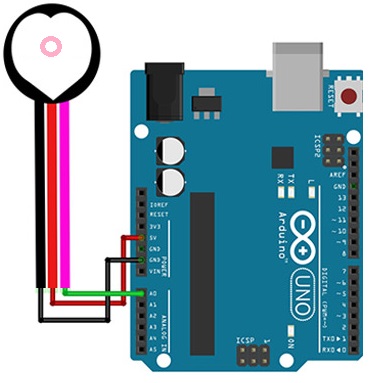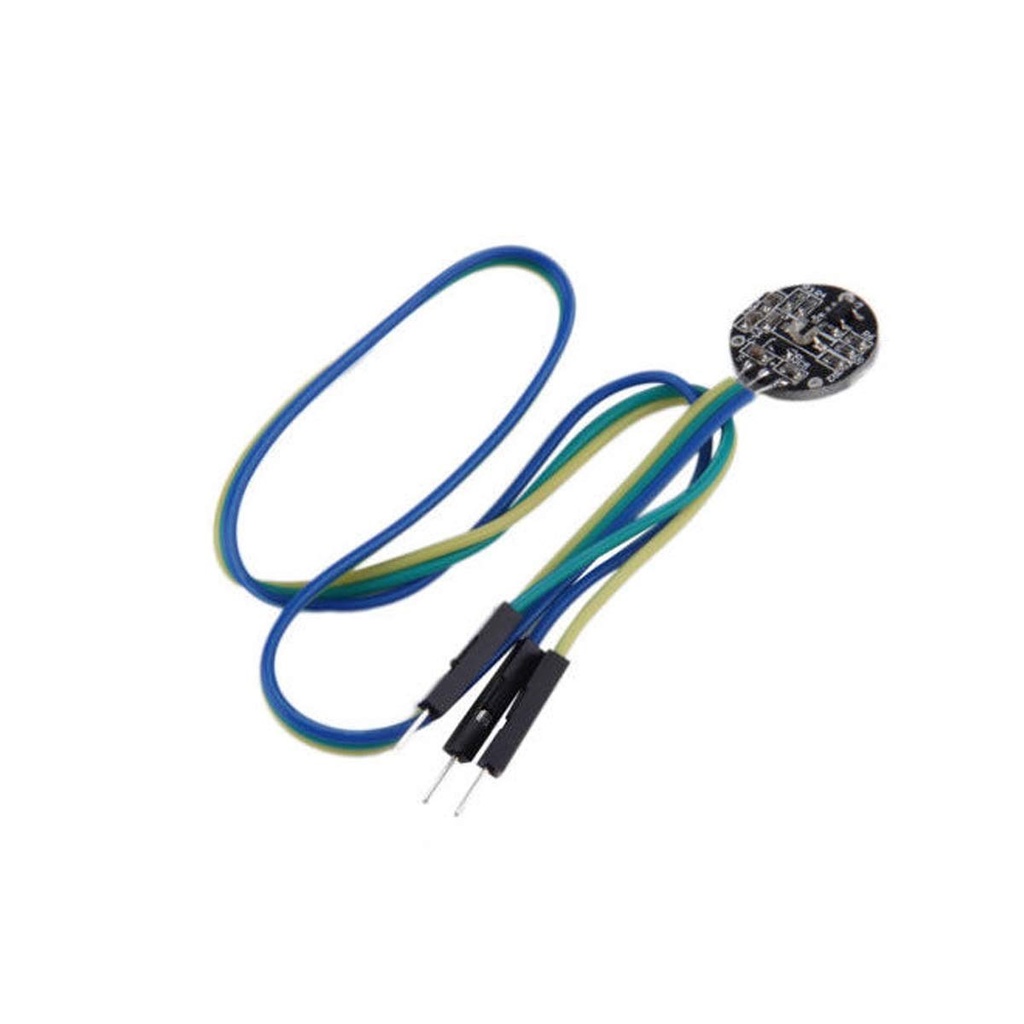Features:
- Accurate Heart Rate Monitoring: Utilizes optical sensing technology to detect and monitor heart rate in real-time.
- Plug-and-Play Compatibility: Easily integrates with Arduino and other microcontrollers without complex wiring.
- Pre-Soldered Wires: Comes with pre-soldered wires for secure and easy connections.
- Compact and Versatile: Fits well in various applications such as wearables and health monitoring systems.
- Low Power Consumption: Operates efficiently with minimal power usage, ideal for battery-powered projects.
- Integrated Circuits: Built-in amplifying and noise elimination circuits for enhanced accuracy.
- User-Friendly Design: Finger placement area with a heart logo, green LED, and ambient light sensor.
- Reverse Protection Diode: Prevents damage from accidental reverse polarity connection.
Description:
This compact module uses advanced optical sensing to provide real-time heart rate data. It's plug-and-play compatible with Arduino, comes with pre-soldered wires, and has integrated circuits for accurate signal processing. Designed for both beginners and advanced users, it features a finger placement logo, a green LED, and automatic brightness adjustment. A reverse protection diode ensures safe operation even under faulty wiring conditions.
Principle of Work:
- Optical Sensing: An IR LED and photodiode detect changes in light absorption caused by blood flow.
- Blood Volume Changes: Fluctuations in reflected light correlate with the heartbeat.
- Amplification and Filtering: Internal circuits amplify signals and eliminate noise.
- Signal Processing: The sensor processes light intensity variations to extract heart rate data.
- Output: Provides analog signals for real-time monitoring and interfacing.
Pinout of the Module:

- VCC: Power input (3.3V or 5V).
- GND: Ground connection.
- Signal: Analog signal output for heart rate data.
Applications:
- Health and Fitness Monitoring: Real-time monitoring in wearables and fitness devices.
- Medical Devices: Integration into ECG and patient monitoring systems.
- Biometric Authentication: Heart rate-based identity verification.
- Stress and Emotion Monitoring: Analyze physiological responses for mental health tracking.
- Research and Development: Collect physiological data for studies and experiments.
- Gaming and VR: Create interactive experiences based on user heartbeat.
- IoT Applications: Use in smart health systems and remote monitoring.
Circuit:

Library:
No library required.
Example Code:
const int PulseSensorPurplePin = A0; // Connects to analog pin A0
const int LED13 = 13; // Built-in LED on pin 13
int Signal; // Stores raw signal data
const int Threshold = 550; // Threshold for heartbeat detection
void setup() {
pinMode(LED13, OUTPUT); // Set LED pin as output
Serial.begin(9600); // Begin serial communication
}
void loop() {
Signal = analogRead(PulseSensorPurplePin); // Read sensor data
Serial.println(Signal); // Print to Serial Plotter
if (Signal > Threshold) {
digitalWrite(LED13, HIGH); // LED on = heartbeat detected
} else {
digitalWrite(LED13, LOW); // LED off = no beat
}
delay(10); // Small delay for stability
}
Code Explanation:
- Defines constants for sensor input and LED output.
- Initializes LED pin and serial communication in
setup().
- In
loop(), reads analog data, prints to Serial Plotter, and toggles the LED based on signal threshold.
Technical Details:
- Dimensions: 16 mm diameter, 3 mm thickness
- Working Voltage: 3-5 V
- Working Current: 4 mA @ 5 V
- Cable Length: 18 cm
- Connections: GND, VCC, analog signal out
Resources:
Comparison with AD8232 Heart Rate Monitor:
- Functionality: Pulse Sensor provides heart rate only, while AD8232 offers heart rate and ECG.
- Sensing Technology: Pulse Sensor uses optical IR sensing; AD8232 uses ECG electrodes.
- Output: Pulse Sensor outputs analog heart rate signal; AD8232 outputs digital ECG data.
- Signal Processing: AD8232 has built-in advanced processing; Pulse Sensor requires external filtering for complex analysis.
- Applications: Pulse Sensor suits fitness and wearables; AD8232 fits medical and research applications.
- Power: Both operate at 3-5V; consumption may vary by use case.
Features:
- Accurate Heart Rate Monitoring: Utilizes optical sensing technology to detect and monitor heart rate in real-time.
- Plug-and-Play Compatibility: Easily integrates with Arduino and other microcontrollers without complex wiring.
- Pre-Soldered Wires: Comes with pre-soldered wires for secure and easy connections.
- Compact and Versatile: Fits well in various applications such as wearables and health monitoring systems.
- Low Power Consumption: Operates efficiently with minimal power usage, ideal for battery-powered projects.
- Integrated Circuits: Built-in amplifying and noise elimination circuits for enhanced accuracy.
- User-Friendly Design: Finger placement area with a heart logo, green LED, and ambient light sensor.
- Reverse Protection Diode: Prevents damage from accidental reverse polarity connection.
Description:
This compact module uses advanced optical sensing to provide real-time heart rate data. It's plug-and-play compatible with Arduino, comes with pre-soldered wires, and has integrated circuits for accurate signal processing. Designed for both beginners and advanced users, it features a finger placement logo, a green LED, and automatic brightness adjustment. A reverse protection diode ensures safe operation even under faulty wiring conditions.
Principle of Work:
- Optical Sensing: An IR LED and photodiode detect changes in light absorption caused by blood flow.
- Blood Volume Changes: Fluctuations in reflected light correlate with the heartbeat.
- Amplification and Filtering: Internal circuits amplify signals and eliminate noise.
- Signal Processing: The sensor processes light intensity variations to extract heart rate data.
- Output: Provides analog signals for real-time monitoring and interfacing.
Pinout of the Module:

- VCC: Power input (3.3V or 5V).
- GND: Ground connection.
- Signal: Analog signal output for heart rate data.
Applications:
- Health and Fitness Monitoring: Real-time monitoring in wearables and fitness devices.
- Medical Devices: Integration into ECG and patient monitoring systems.
- Biometric Authentication: Heart rate-based identity verification.
- Stress and Emotion Monitoring: Analyze physiological responses for mental health tracking.
- Research and Development: Collect physiological data for studies and experiments.
- Gaming and VR: Create interactive experiences based on user heartbeat.
- IoT Applications: Use in smart health systems and remote monitoring.
Circuit:

Library:
No library required.
Example Code:
const int PulseSensorPurplePin = A0; // Connects to analog pin A0
const int LED13 = 13; // Built-in LED on pin 13
int Signal; // Stores raw signal data
const int Threshold = 550; // Threshold for heartbeat detection
void setup() {
pinMode(LED13, OUTPUT); // Set LED pin as output
Serial.begin(9600); // Begin serial communication
}
void loop() {
Signal = analogRead(PulseSensorPurplePin); // Read sensor data
Serial.println(Signal); // Print to Serial Plotter
if (Signal > Threshold) {
digitalWrite(LED13, HIGH); // LED on = heartbeat detected
} else {
digitalWrite(LED13, LOW); // LED off = no beat
}
delay(10); // Small delay for stability
}
Code Explanation:
- Defines constants for sensor input and LED output.
- Initializes LED pin and serial communication in
setup().
- In
loop(), reads analog data, prints to Serial Plotter, and toggles the LED based on signal threshold.
Technical Details:
- Dimensions: 16 mm diameter, 3 mm thickness
- Working Voltage: 3-5 V
- Working Current: 4 mA @ 5 V
- Cable Length: 18 cm
- Connections: GND, VCC, analog signal out
Resources:
Comparison with AD8232 Heart Rate Monitor:
- Functionality: Pulse Sensor provides heart rate only, while AD8232 offers heart rate and ECG.
- Sensing Technology: Pulse Sensor uses optical IR sensing; AD8232 uses ECG electrodes.
- Output: Pulse Sensor outputs analog heart rate signal; AD8232 outputs digital ECG data.
- Signal Processing: AD8232 has built-in advanced processing; Pulse Sensor requires external filtering for complex analysis.
- Applications: Pulse Sensor suits fitness and wearables; AD8232 fits medical and research applications.
- Power: Both operate at 3-5V; consumption may vary by use case.


